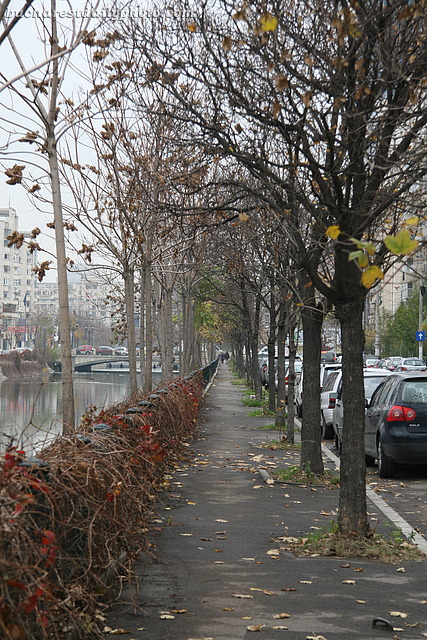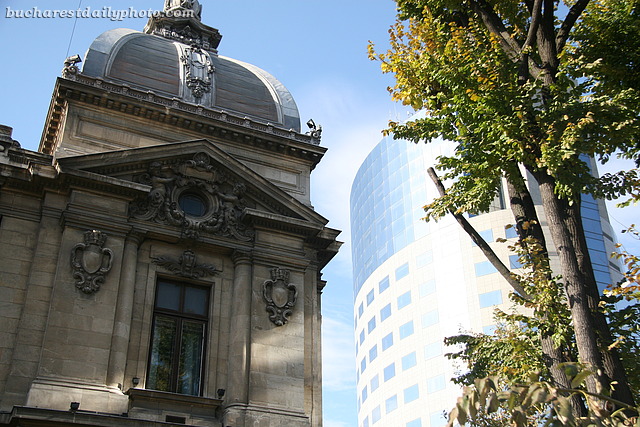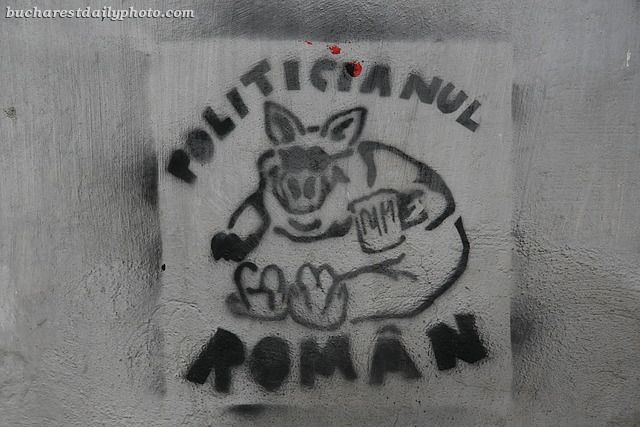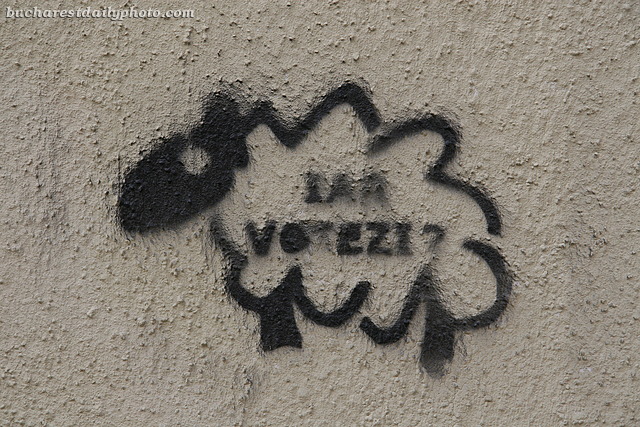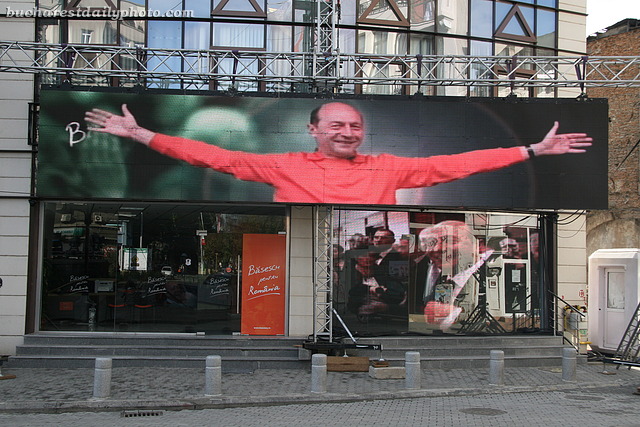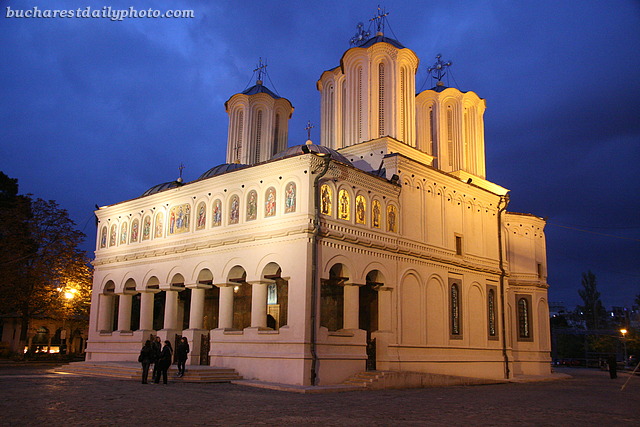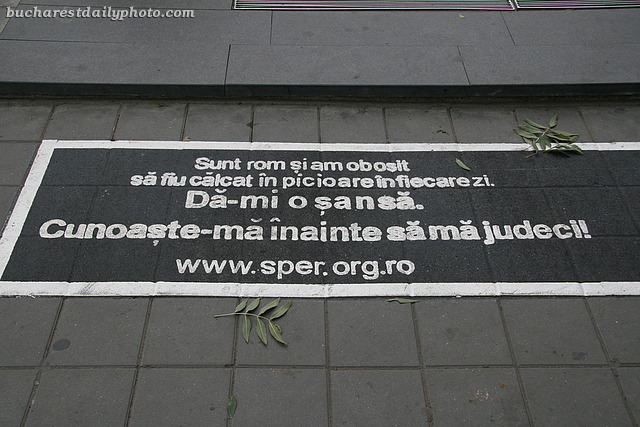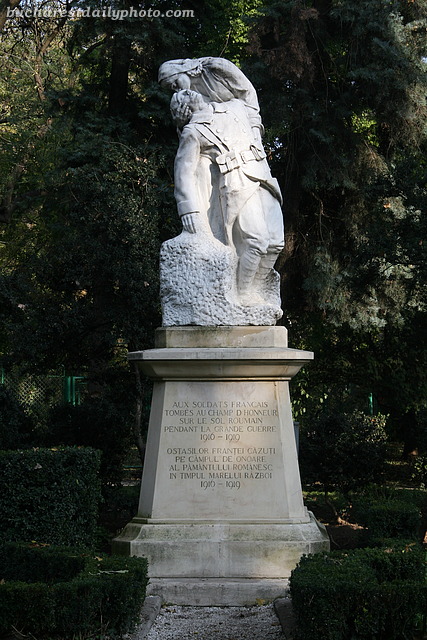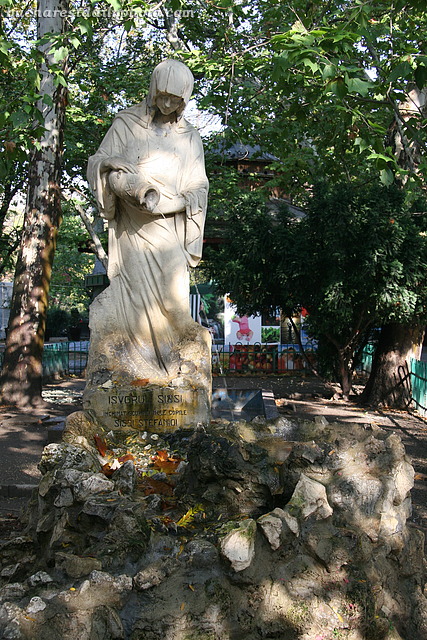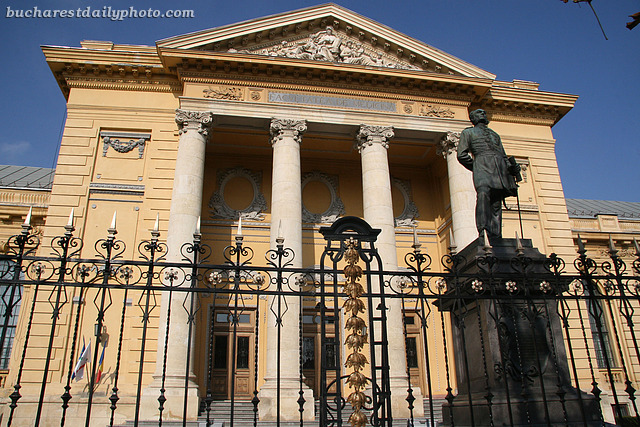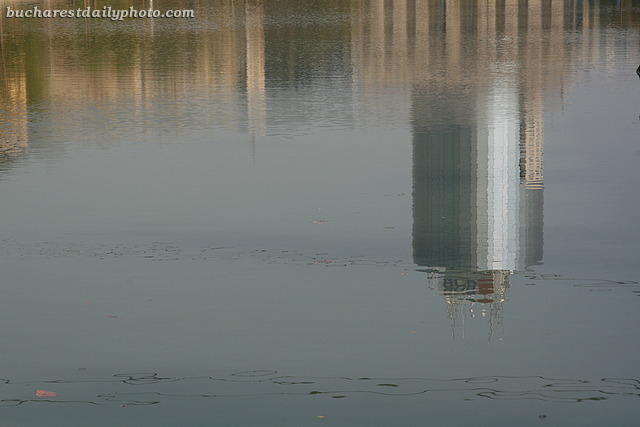November is not one of my favourite months. I’m not used to the cold yet, the grey skies make me want to sit in bed all day and the frequent raining does nothing to improve the situation. But there are two things that I like about November. The first is the approach of the winter holidays. The second are the fall colors, which can make even a mundane landscape like the one in today’s photo look interesting. I took the photo along Dâmboviţa River between Timpuri Noi and Mărăşeşti.
I’ve talked about the contrast shown in today’s photo in on older post, the old bank rubbing elbows with the new business center (a former bank), but the picture was taken from afar and I thought it would be nice to show you a close-up as well.
Keeping with the elections theme, these are two stencil graffiti that I photographed on my last stroll through the Old Town. The first represents, according to its author, the portrait of the Romanian politician. The second one, which I don’t think I understand entirely, is of a sheep which has the message “Are you gonna vote again?” written on it. I’m not sure if the author has lost faith in the political system and is trying to say that no matter who you vote it won’t matter or is referring to the uninformed voters, the ones who go to vote because the village mayor or the local priest told them to do so and also told them who to vote with.
These days Romania’s enjoying the full swing of an electoral campaign. Presidential elections will be held on November 22nd together with a referendum concerning the reducing the number of elected parliamentarians from 471 to 300 and moving from a two chamber system to a unicameral one given that the powers of the two houses are nowadays largely similar and the bicameral system has led to legislative gridlock in the past. There are 12 candidates for the seat of president but only three of them have real chances. It is not expected that anyone will get majority in the first round and we’ll probably have to go to vote again on December 6th. The city is full of advertisement related to the campaign. The smiling guy that appears in my photograph is the incumbent, our current president, Traian Băsescu, who is running for reelection. A former ship captain, Minister of Transport and Mayor of Bucharest, he is a somewhat controversial figure in Romania. People either love him or hate his guts and nobody remains indifferent. The opponent closest in the polls is the Social Democratic Party candidate, Mircea Geoană, former Foreign Minister of Romania and former ambassador to the United States.
This elegant building is the center of the Romanian Orthodox Church which sits atop the Mitropoliei Hill. Bucharest has a string of small hills and in the past monasteries were built on top of these hills so they can be seen from afar. In the past the Patriarchal Cathedral was visible from most parts of the city but that has been rectified by the communists which fenced it with tall buildings. It’s a miracle that the building has not been demolished or moved somewhere else during the communist regime, as it happened with many other churches, but that may be due to the fact that the leaders of the Romanian Orthodox Church collaborated with the Communist Party in order to maintain what was left of their power. During the 15th century the Mitropoliei Hill was covered by vineyards and a small wooden church stood on top of it. Construction of the new church was started by Prince of Wallachia Constantin Şerban Basarab in 1656 and finished by Radu Leon in 1668 when it was named the official Metropolitan seat. None of the original interior paintings remain except for a single icon depicting the Saint Emperors Constantine and Helen which are the cathedral’s patron saints. The church was restored several times. The present day frescoes were painted by Dimitrie Belisarie in 1933. This is a place of gathering, and thousands of people take to the hill with the occasion of major religious holidays.
This message written on the pavement is part of a campaign for the integration of gypsies. They appeared all over the city center about two or three weeks ago. The message reads “I am romani (the pc way to say gypsy) and I’m tired to be stepped on every day. Give me a chance. Know me before you judge me!”. It would be good if this campaign would change opinions but I doubt it. There were other campaigns like this in the past but the situation is unchanged. But, gypsies aside, what everybody should learn from this message is that we should try to get to know people before we judge them.
Today’s photo shows another beautiful sculpture in Cişmigiu Park, the Monument of the French Soldiers, which honors the French soldiers who died on Romanian soil during the First World War. It seems to be the most popular monument in the park cause every time I pass by I see people taking pictures of it. It depicts a French soldier dying in the arms of a Romanian peasant woman. It was unveiled in October 1922 in the presence of French Marshal Ferdinand Foch. The sculptor Ion Jalea, a war veteran himself, was awarded the “National Order of the Legion of Honour”, the highest decoration in France.
Cişmigiu Park is one of my favourite places in Bucharest. In my college days I used to stroll these paths almost every day, hand in hand with my sweetheart, talking about our plans and the world as we saw it through the eyes of two 20 year olds. Back in those days I used to spend a considerable amount of time in Cişmigiu. After I graduated and started to work, I rarely found the time to go to the park. But since starting this blog I’ve been passing through Cişmigiu a lot, in search for subjects to photograph. I always find something worth photographing there, like the black swan or the patriotic benches that I showed to you on previous posts. Cişmigiu has some nice landmarks or points of attraction which I have yet to photograph so I have plenty of reasons to return to the park. Today’s photo shows one of these landmarks, “The Sissi Spring”. This beautiful statue was created by the sculptor Dimitriu Bârlad (1890-1964) and depicts a mother mourning the death of her daughter, pouring water from a pitcher. The engraving reads “Dedicated to my beloved daughter Sissi Stefanidi”.
The first medical school was established in Romania in 1857, by a French expatriate medic by the name of Carol Davila (1828-1884). The healthcare system in Romania had been in existence since around 1700 but the doctors were schooled abroad in countries like France, Italy or Austria. As a side note, today it’s the other way around, doctors get schooled in Romania and go to practice abroad. In 1869 the National School of Medicine and Pharmacy became a department of the University of Bucharest and the first doctoral degrees were granted in 1873. In 1903 the school got a new building, which you can admire in today’s photo, designed in French neoclassical style by Louis Blanc. Fittingly, the statue that appears in front of the main entrance is of Carol Davila. It was created by the sculptor Carol Storck.
First of all my apologies if you tried to access Bucharest Daily Photo in the morning. I’m hosting the website on a server at home and this morning we had a power outage for three hours. I hope this won’t happen too often. I have a UPS but it’s a small one and can only sustain the server for 40 minutes. Most times that’s enough but this time it wasn’t.
Back to today’s photograph. I like reflections photographs and I like to try my hand at shooting reflections every time I find some shiny surface and something nice that reflects on it. So in today’s photo you can see one of my attempts, the tower of the Bucharest Financial Plaza reflecting on the surface of the river Dâmboviţa.
